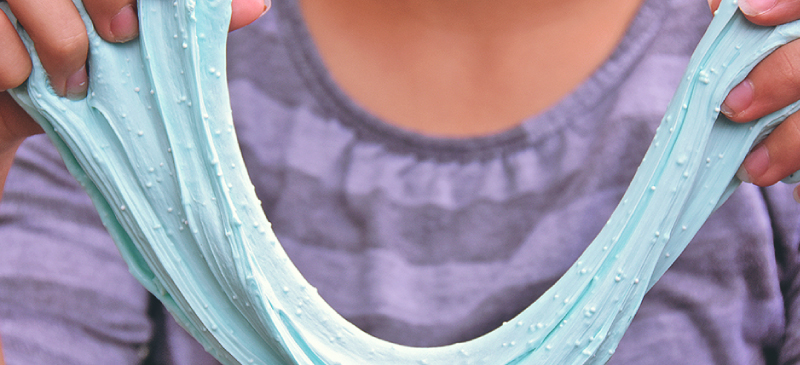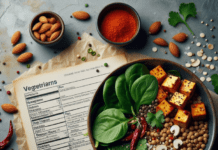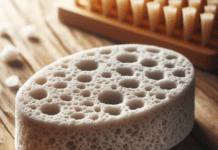Toy slime is all the rage today, with approximately 5 million posts on Instagram under the #slime hashtag.
This is because mud is both fun and stimulating for developing brains as a form of sensory play!
Playing with the ooey-gooey concoction dubbed slime can be considered a STEM activity, which stands for science, technology, engineering, and mathematics.
You can even use it for a fun family activity to practice the scientific method! Children can be shown how to form a hypothesis, experiment, and form conclusions while making slime.
A lot of DIY slime recipes call for ingredients that you don’t want your children handling.
Rather than reaching into the cleaning cabinet for your components, head to your pantry instead and get out psyllium husks, measuring cups, measuring spoons, water, and natural food coloring (optional).
Read on for my natural, all-natural DIY slime recipe.
Because the method is edible, it is perishable, and you will want to store the slime in the refrigerator when not in use.
One of the best parts about this DIY slime recipe is that I am going to show you how to make slime less sticky than traditional recipes, which makes for easy clean up with warm water!
DIY Slime Recipe
Total Time: 20 minutes
Ingredients
8 ounces of water
One tablespoon psyllium husk
natural food coloring (optional)
Directions
- Pour 8 ounces of water into a small-to-medium saucepan.
- Add food coloring if you are using it.
- Add one tablespoon finely ground psyllium husk to water and stir well. If the psyllium husk is not finely ground, you may rub it in a coffee or nut grinder for a powder-like consistency.
- Turn stove heat to medium-high. Observe, and when the mixture begins to bubble, turn the heat down to medium-low and simmer for 5 minutes. DO NOT STIR, as this will affect the finished product.
- At the 5 minute mark, remove from heat. Carefully pour into a small container and place in the refrigerator to cool. As soon as it is cold, let the fun begin!
Slime Recipe Facts
Most homemade and commercial slimes are considered polymers that are made by combining polyvinyl alcohol solutions, such as glue, with sodium borate ions, which are found in Borax.
Other slime recipes may include eye drops, liquid starch, and laundry detergent, most of which are not intended to be in direct contact with skin and certainly are not to be put in the mouth.
Can you make Slime Recipe with glue and shaving cream?
Yes, but because young children learn about their environment through the use of all five senses (touch, taste, smell, sight, and sound),
I wanted to create a slime recipe that would stimulate their senses while being completely safe, non-toxic, and, technically, even edible!
Because of its chemical properties, glue can make an extremely stretchy slime as it bonds with borate ions.
And when consumers want to learn how to make fluffy slime, they often use shaving cream to create an airy final product.
Unfortunately, even as people search for how to make slime with baking soda, the result usually better resembles play dough or putty.
I will show you how to make fluffy slime without Borax, or other potentially hazardous ingredients. Let’s take a closer look at some of the common ingredients used to make slime and why we chose safer alternatives.
Slime Ingredients to Avoid
Glue
Even when labeled “nontoxic,” school glue is not intended to be in direct contact with the skin. Additionally, manufacturers instruct consumers to contact a POISON CENTER if any paste is accidentally consumed.
Most young children experiment with their world by putting things in their mouths, which makes the average slime containing glue very dangerous! Because of this, more and more parents want to learn how to make slime without glue.
Borax
Borax irritates the skin and eyes, and it can also disrupt hormones. Increased exposure to borate ions has even been linked to causing harm to the male reproductive system!
These are the primary reasons I wanted to share how to make slime without Borax.
Eye Drops
Many commercial eye drops contain a medication called tetrahydrozoline, which, as with any medication, should be handled with extreme caution
Liquid Starch
This is another ingredient not intended to be in direct contact with the skin or mouth. It may cause skin irritation or more serious problems if ingested, and medical treatment is recommended
Laundry Detergent
Even those that are considered “free and clear” can be highly toxic, causing a host of issues such as respiratory problems, skin irritation, reproductive/hormonal disruption, cancer, and environmental issues
Shaving Cream
Although intended to be used on the skin, typical commercial shave creams and foams contain chemical ingredients that are proven skin, eye, respiratory, and gastrointestinal irritants
, which may not be safe for use by young children. Although often used to make fluffy slime, I prefer to avoid toxic ingredients as much as possible.
How do you make easy slime?
With thousands of recipes online, the easiest DIY slime recipe is made with the least amount of ingredients and steps.
My recipe has two main parts, one of which is water, and coloring is optional. Check how to make alternatives to food coloring easily with the use of kitchen ingredients in my homemade finger paint recipe!
How do you make fluffy slime without Borax?
As we previously discussed the dangers of allowing children to handle Borax, many parents are seeking alternatives to making fluffy slime.
Fun Ways to Use Slime!
As with other forms of sensory play, such as my homemade bubbles and playdough, allowing children to help you make and play with this DIY slime recipe gets them thinking creatively!
With adult supervision, children can learn about slime’s unique characteristics as they gather, measure, and mix ingredients to witness the chemical creation of a liquid that acts as a solid, which is called a “non-Newtonian fluid.”
It feels solid when handled, but oozes like a liquid. When pulled slowly, it will stretch, but if pulled too quickly, it will break apart.
It can be molded into a ball, and can also ooze into the shape of the container in which it is stored. Slime can be used to teach cause and effect, gravity, liquid to stable, and stable to cash. The options are endless!
Easy DIY Slime Recipe with 3 Natural Ingredients
Ingredients:
- 8 ounces of water
- One tablespoon psyllium husk
- natural food coloring (optional)
Directions:
- Pour 8 ounces of water into a small-to-medium saucepan.
- Add natural food coloring, if you are using it.
- Add one tablespoon finely ground psyllium husk to water and stir well. If the psyllium husk is not finely ground, you may rub it in a coffee or nut grinder for a powder-like consistency.
- Turn stove heat to medium-high. Observe, and when the mixture begins to bubble, turn the heat down to medium-low and simmer for 5 minutes. DO NOT STIR.
- 4. At the 5-minute mark, remove from heat. Carefully pour into a small container and place in the refrigerator to cool.








